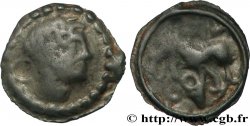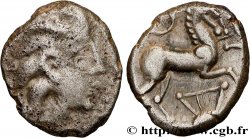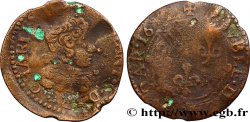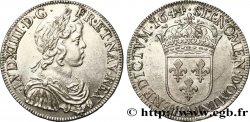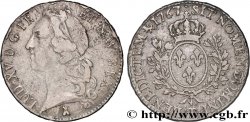v57_0435 - GALLIA - GALLIA DELLO SETTENTRIONALE - ÆDUI (BIBRACTE, Regione dello Mont-Beuvray) Statère en électrum au triskèle, type de Chenôves
MONNAIES 57 (2013)
Начальная цена : 600.00 €
Назначить цену : 900.00 €
непроданный лот
Начальная цена : 600.00 €
Назначить цену : 900.00 €
непроданный лот
Тип Statère en électrum au triskèle, type de Chenôves
Дата: c. 70-50 AC.
Монетный двор / Город: Autun (71)
Металл: electrum
Диаметр: 16,5 mm
Ориентация осей монеты: 9 h.
Вес: 6,44 g.
Редкость: R2
Комментарии о состоянии
Statère frappé sur un flan court et très épais, avec des types complets et bien identifiables des deux côtés, mais de frappe molle ou issu de coins usés. Patine sombre et brillante, comme anciennement astiquée, avec un métal hétérogène et très fortement chargé en cuivre
Лицевая сторона
Аверс: легенда: ANÉPIGRAPHE.
Аверс: описание: Tête humaine laurée à gauche, la chevelure stylisée ; grènetis.
Обратная сторона
Реверс: легенда: ANÉPIGRAPHE.
Реверс: Описание: Cheval galopant à gauche ; au-dessus du cheval, l'aurige ; triskèle sous le cheval.
Комментарий
Ces monnaies du type de Chenôves se divisent en trois types ; à la lyre (classe I), à la rouelle (classe II) ou au triskèle (classe III).
Ce statère de la classe III correspond exactement au DT. 3181. Un exemplaire de cette classe et provenant du trésor de Chenôves présente un cheval androcéphale (n° 11 du musée de Mâcon).
Cet exemplaire est particulièrement complet pour ce type !.
Ce statère de la classe III correspond exactement au DT. 3181. Un exemplaire de cette classe et provenant du trésor de Chenôves présente un cheval androcéphale (n° 11 du musée de Mâcon).
Cet exemplaire est particulièrement complet pour ce type !.








 Cообщить об ошибке
Cообщить об ошибке Распечатать страницу
Распечатать страницу Отправить мой выбор
Отправить мой выбор Задать вопрос
Задать вопрос Consign / sell
Consign / sell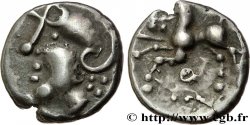
 Информация
Информация

